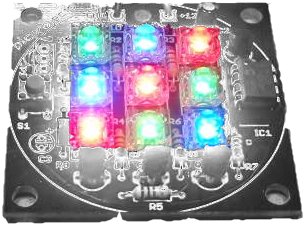The appeal of these chips is that they are very cheap, and seem to be quite versatile. You can use them for building little custom-made devices that flash lights, read sensors etc.
The downside is that they're not for beginners. You need to be handy with a soldering iron and, if you want to get the chip to do anything other than what it was pre-programmed to do, you need to get your hands dirty with some programming. From what I have seen, it's not easy programming either. These chips don't have a high-level language built in, so you're looking at something akin to Assembly language if you want to write your own programs.
That doesn't scare me though. I don't know much assembly yet, but I'm willing to learn. For starters, I wanted to get my hands on a little beginners kit and try it out, so I chose the LED mood board kit.
 This thing has 9 LEDs and a bunch of resistors and capacitors, all of which need to be soldered together, and a pre-programmed PIC chip. Fix it all up, plug it in and away it goes, cycling colours through a bunch of sequences. You can write your own programs with an adaptor kit (to attach it to your PC), but I haven't done that yet.
This thing has 9 LEDs and a bunch of resistors and capacitors, all of which need to be soldered together, and a pre-programmed PIC chip. Fix it all up, plug it in and away it goes, cycling colours through a bunch of sequences. You can write your own programs with an adaptor kit (to attach it to your PC), but I haven't done that yet.
Louis loves the light on its own, even as a bare circuit board. It's really bright, and lights up the room.
Hopefully I'll get around to programming it and then move onto the 5x5 monster, but not for a little while.
No comments:
Post a Comment